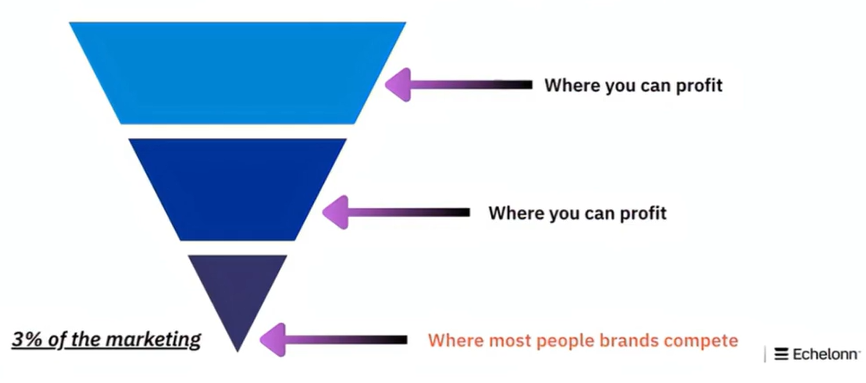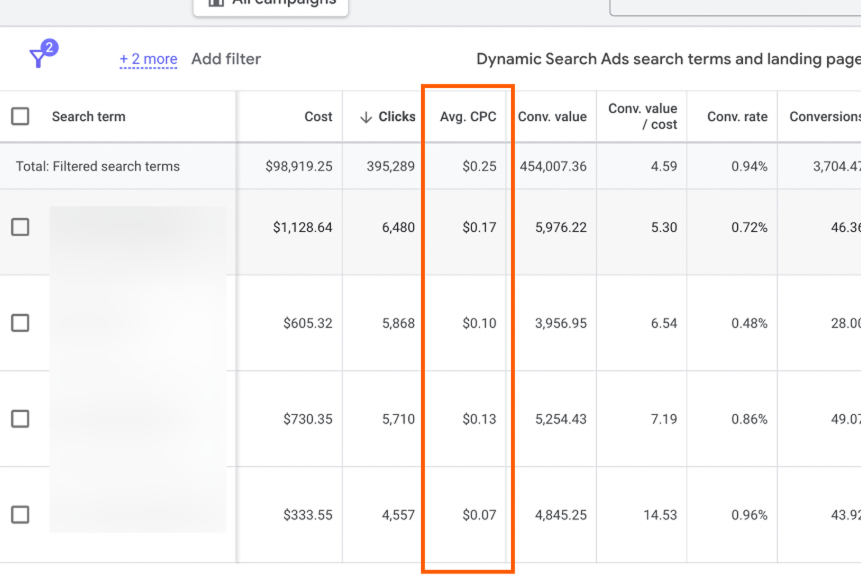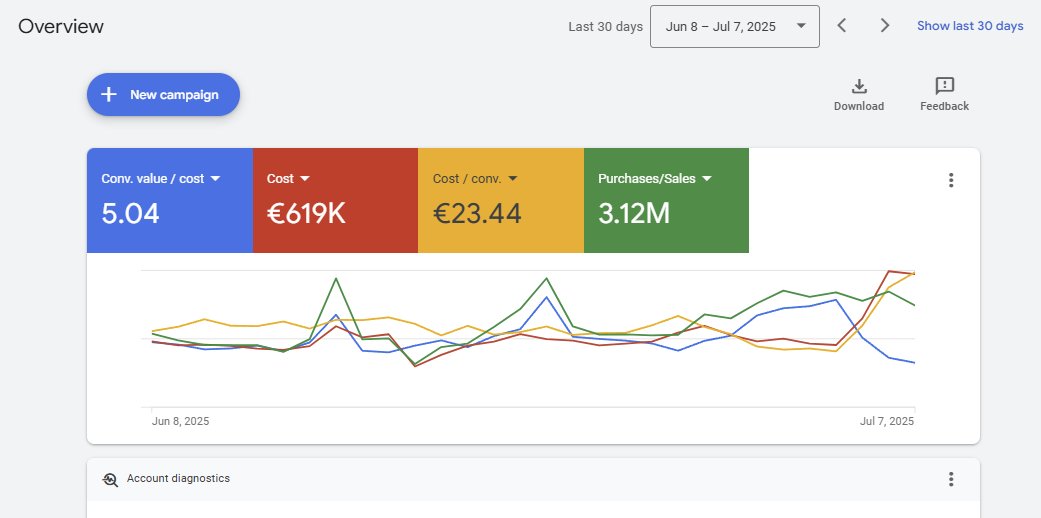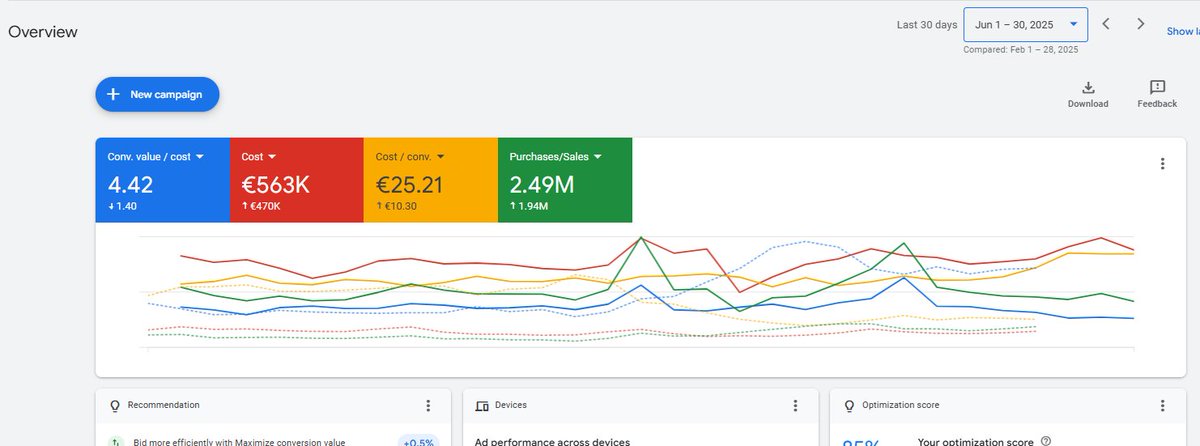Everyone thinks you need a fat budget to win with Google Ads.
Truth is, you just need to outthink, not outspend, your competitors.
Here’s the setup we use to dominate with minimal spend:
Truth is, you just need to outthink, not outspend, your competitors.
Here’s the setup we use to dominate with minimal spend:

Let’s start with a tough truth:
If you don’t have much to spend, you can’t copy what big brands do.
You can’t afford 30 campaigns running at once.
Instead, you have to play the efficiency game.
Every dollar has to work hard.
If you don’t have much to spend, you can’t copy what big brands do.
You can’t afford 30 campaigns running at once.
Instead, you have to play the efficiency game.
Every dollar has to work hard.
And that’s where many small-budget brands go wrong.
They try to run everything at once.
Search, Display, Shopping, Performance Max.
As a result, Google doesn’t get enough data to learn what’s working.
So which campaign should you run?
They try to run everything at once.
Search, Display, Shopping, Performance Max.
As a result, Google doesn’t get enough data to learn what’s working.
So which campaign should you run?
Here’s the brand launch strategy we recommend for brands with limited ad spend:
- Start with Shopping
- Layer in Search & PMax
- Expand to Demand Gen
Let’s break it down in more detail…
- Start with Shopping
- Layer in Search & PMax
- Expand to Demand Gen
Let’s break it down in more detail…
1. Start with Shopping ads.
Shopping campaigns are a great launchpad for small brands.
• They show your product visually
• They attract high-intent buyers
• They’re easier to optimize
If you’ve got a few hundred bucks per month, this is your best chance of making sales.
Shopping campaigns are a great launchpad for small brands.
• They show your product visually
• They attract high-intent buyers
• They’re easier to optimize
If you’ve got a few hundred bucks per month, this is your best chance of making sales.
2. Research your competitors
You won’t win by going head-to-head with bigger brands.
Instead, look for smarter ways to compete:
• Target less competitive traffic
• Stand out in the search results
It starts with keyword research.
You won’t win by going head-to-head with bigger brands.
Instead, look for smarter ways to compete:
• Target less competitive traffic
• Stand out in the search results
It starts with keyword research.
3. Keyword research
Use Google's keyword planner to check search volume, top-of-page bids, and competition levels.
Avoid broad, competitive keywords.
Look for cheaper terms that still align with your product and goals.
Use Google's keyword planner to check search volume, top-of-page bids, and competition levels.
Avoid broad, competitive keywords.
Look for cheaper terms that still align with your product and goals.
Aim for that sweet spot:
• Popular enough to get traffic.
• Affordable enough to stay profitable.
Go for long-tail searches like “men's running shoes size 10.”
This gets you more qualified clicks without overspending.
• Popular enough to get traffic.
• Affordable enough to stay profitable.
Go for long-tail searches like “men's running shoes size 10.”
This gets you more qualified clicks without overspending.
4. Differentiate in the search results
Once you find your keywords, make your listings stand out.
Improve what shoppers actually see:
• Better photos
• Stronger offers & reviews
• More relevant product titles
• Faster shipping & clearer return policies
Once you find your keywords, make your listings stand out.
Improve what shoppers actually see:
• Better photos
• Stronger offers & reviews
• More relevant product titles
• Faster shipping & clearer return policies
Never race to the bottom on price.
If a competitor is cheaper, that’s fine. Your job is to make your product look more valuable.
When perceived value is high, price becomes secondary.
If a competitor is cheaper, that’s fine. Your job is to make your product look more valuable.
When perceived value is high, price becomes secondary.
5. Optimize Google Merchant Center (GMC)
Your product feed is the backbone of Shopping ads.
It’s where Google pulls in your product titles, photos, prices, shipping info, and reviews.
It decides which searches your ads appear for and how high you rank.
Your product feed is the backbone of Shopping ads.
It’s where Google pulls in your product titles, photos, prices, shipping info, and reviews.
It decides which searches your ads appear for and how high you rank.
This is where you can outwork the competition.
We’ve audited 500+ accounts. Almost nobody puts effort into this.
But when you do, Google will reward you with better placement, higher CTR, and more sales.
And none of it requires increasing your ad spend.
We’ve audited 500+ accounts. Almost nobody puts effort into this.
But when you do, Google will reward you with better placement, higher CTR, and more sales.
And none of it requires increasing your ad spend.
Focus on getting these things right:
• Accurate shipping info
• Clear return policies
• High-quality product photos
• Keyword-optimized titles
• Verified customer reviews
Nail these, and you’ll already be ahead of 90% of the competition.
• Accurate shipping info
• Clear return policies
• High-quality product photos
• Keyword-optimized titles
• Verified customer reviews
Nail these, and you’ll already be ahead of 90% of the competition.
We created a Product Feed Optimization Checklist to make this easier for you.
It’s the same one we’ve used for our clients across $10M in monthly ad spend.
Grab it here.
resources.echelonn.io/gmc-pf-checkli…
It’s the same one we’ve used for our clients across $10M in monthly ad spend.
Grab it here.
resources.echelonn.io/gmc-pf-checkli…
6. Double-check your tracking.
If your tracking is wrong, you’re scaling based on fake data.
Are sales double-counted?
Are you tracking branded vs non-branded sales correctly?
Do your ad metrics match your actual sales?
Don’t skip this.
If your tracking is wrong, you’re scaling based on fake data.
Are sales double-counted?
Are you tracking branded vs non-branded sales correctly?
Do your ad metrics match your actual sales?
Don’t skip this.
7. Be patient
Many brand owners panic when they don’t see instant results.
Google's algorithm needs 60-90 days to understand who your best customers are and where to find them.
Give your campaigns time to gather data. Don’t touch too much too early.
Many brand owners panic when they don’t see instant results.
Google's algorithm needs 60-90 days to understand who your best customers are and where to find them.
Give your campaigns time to gather data. Don’t touch too much too early.
And remember, ads are just one part of the system.
• Match your landing page to the search
• Improve conversion rate with great UX
• Collect emails to build lifetime value
• Show up on other platforms to boost branded search
Everything works together.
• Match your landing page to the search
• Improve conversion rate with great UX
• Collect emails to build lifetime value
• Show up on other platforms to boost branded search
Everything works together.
Once Shopping is performing, that’s your signal to scale.
Start with Search Ads & PMax.
They pair well with Shopping and help you dominate more space on Google.
Start with Search Ads & PMax.
They pair well with Shopping and help you dominate more space on Google.
Then test YouTube Ads and Demand Gen.
These help you reach cold audiences and grow brand awareness.
They also drive more branded searches.
And when branded searches go up, your Shopping and Search campaigns get way more efficient.
These help you reach cold audiences and grow brand awareness.
They also drive more branded searches.
And when branded searches go up, your Shopping and Search campaigns get way more efficient.
• • •
Missing some Tweet in this thread? You can try to
force a refresh











